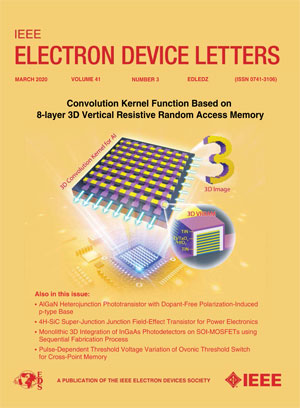Demonstration of a Re-Activatable Scandate Cathode for a High-Current Sheet Beam Electron Gun
IF 4.5
2区 工程技术
Q2 ENGINEERING, ELECTRICAL & ELECTRONIC
引用次数: 0
Abstract
A re-activatable scandate cathode for a high-current sheet beam electron gun was demonstrated in experiment. The re-activatable scandate cathode was impregnated with high purity emission-active materials composed of用于大电流片束电子枪的可再激活阴极的演示
实验证明了一种用于大电流片束电子枪的可再活化阴极。采用聚丙烯酰胺辅助溶胶-凝胶法制备了由$\beta $ -Ba2ScAlO5和Ba3Al2O6组成的高纯发射活性材料,并将其浸渍在可再活化的钪阴极上。发射活性材料是阴极阴极实现低吸湿性和再活化性的必要条件。结果表明,在空气中放置1000小时后,可再活化的鳞片阴极的质量增益只有0.005%,在1140°C时的发射电流密度为42 a /cm2。高性能阴极集成到紧凑的片状电子枪中,该电子枪具有阶梯椭圆聚焦电极,可实现各向异性静电压缩。在阴极温度为1140℃,束流电压为24.6 kV的条件下,电子枪产生的压缩束流峰值电流为189 mA。在三个独立的空气暴露、疏散和再激活周期中,光束电流的变化不超过5%。这些研究结果证实了可再活化阴极适合于大电流片束电子枪。
本文章由计算机程序翻译,如有差异,请以英文原文为准。
求助全文
约1分钟内获得全文
求助全文
来源期刊

IEEE Electron Device Letters
工程技术-工程:电子与电气
CiteScore
8.20
自引率
10.20%
发文量
551
审稿时长
1.4 months
期刊介绍:
IEEE Electron Device Letters publishes original and significant contributions relating to the theory, modeling, design, performance and reliability of electron and ion integrated circuit devices and interconnects, involving insulators, metals, organic materials, micro-plasmas, semiconductors, quantum-effect structures, vacuum devices, and emerging materials with applications in bioelectronics, biomedical electronics, computation, communications, displays, microelectromechanics, imaging, micro-actuators, nanoelectronics, optoelectronics, photovoltaics, power ICs and micro-sensors.
 求助内容:
求助内容: 应助结果提醒方式:
应助结果提醒方式:


